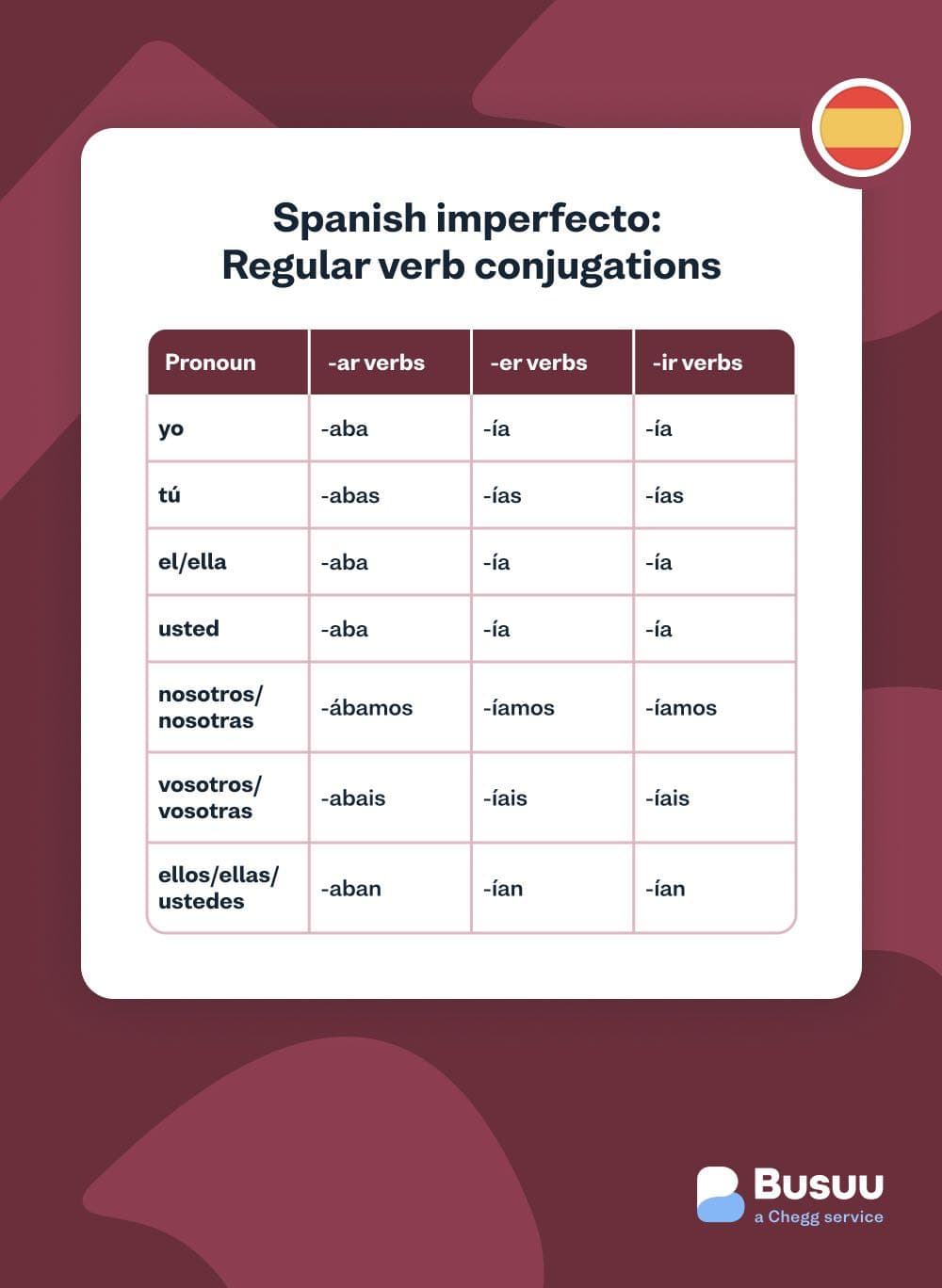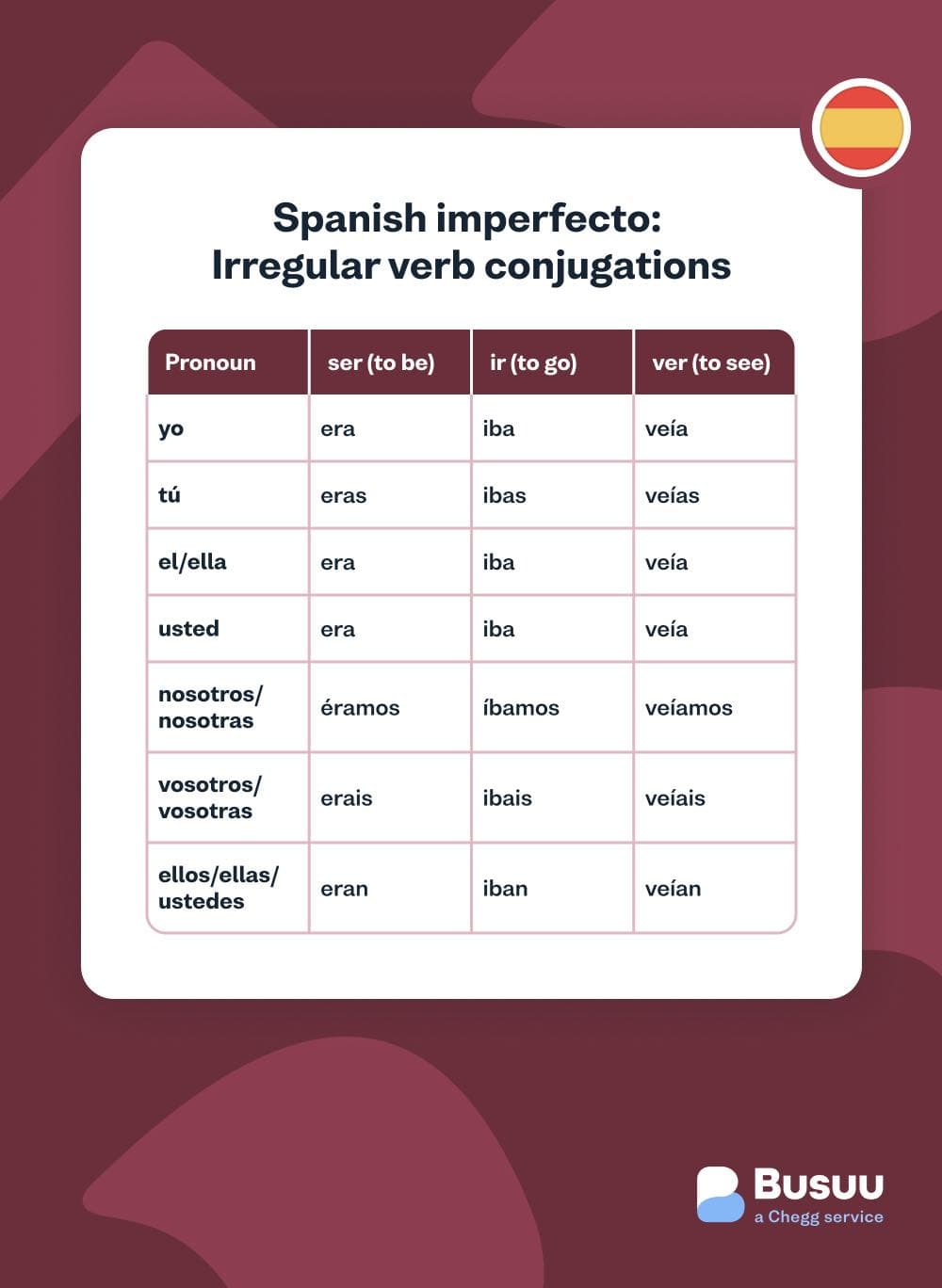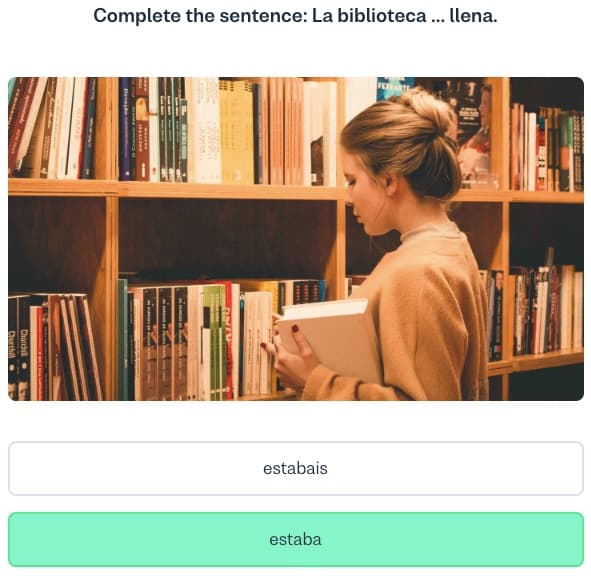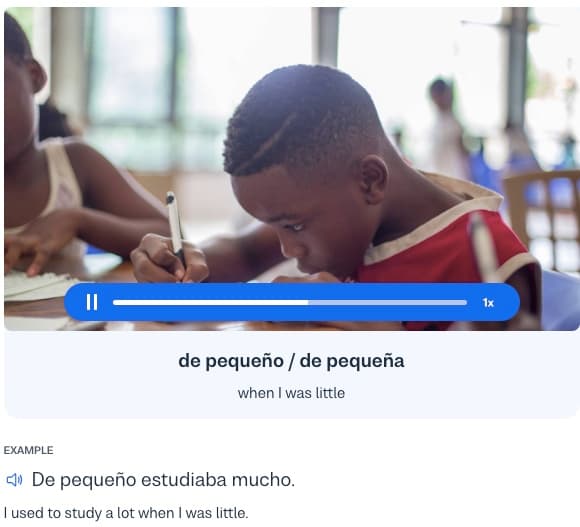I want to learn...
Picture this: you’re sitting with some friends talking about your childhood. You want to set the scene and tell them about things you used to do regularly as a kid. To do so, we use the imperfect past orpretérito imperfectotense in Spanish.
To help you master the basics, we’ll cover the conjugations for regular and irregular verbs, discuss when it is used and how it differs from the simple past tense. We will also look at some examples.
¿Listos? ¡Comencemos!
Ready? Let’s begin!
Imperfect past tense: Spanish regular verbs
The imperfect past tense is another Spanish verb tense used to describe the past.
This handy verb tense describes habits, what was usual or what we did during a certain period of time, and it also describes people, things, or places in the past. And as we’ll see later on, we also use the imperfect past tense to describe continuous actions that took place in the past.
Now, how can we start using it?
Let’s learn conjugations of the imperfect past for regular -ar, -er-, and -ir verbs.
Regular verb conjugations for the imperfect past tense

Regular verb conjugations for the imperfect past tense
| Pronoun | -ar verbs | -er verbs | -ir verbs |
|---|---|---|---|
| yo | -aba | -ía | -ía |
| tú | -abas | -ías | -ías |
| el/ella | -aba | -ía | -ía |
| usted | -aba | -ía | -ía |
| nosotros/nosotras | -ábamos | -íamos | -íamos |
| vosotros/vosotras | -abais | -íais | -íais |
| ellos/ellas/ustedes | -aban | -ían | -ían |
Note: Vosotros / vosotras is mainly used in Spain and not in Latin America, where they tend to use ustedes instead. Check out this article on the differences of Spanish used in Spain and Latin America.
When making a sentence with this tense, we can use the same structure as in the present tense.
subject + verb in imperfect past + complementary information/rest of the sentence
Here you have some examples of regular verbs in the imperfect past:
Yo hablaba con mis amigos todos los días. (I used to talk with my friends every day.)
Tú estudiabas mucho para los exámenes. (You used to study a lot for the exams.)
In these examples, you can see how the imperfect past tense is used to describe habits or things people used to do in the past.
Now that you’ve got the hang of the imperfect past tense for regular verbs, let’s look at the irregular ones.
Imperfect past tense: Spanish irregular verbs
The imperfect past tense only has three irregular verbs: ser (to be), ir (to go), and ver (to see).
Each of these verbs has a special conjugation pattern for the imperfect past tense. Let’s take a look:

Irregular verb conjugations for the imperfect past tense
| Pronoun | ser (to be) | ir (to go) | ver (to see) |
|---|---|---|---|
| yo | era | iba | veía |
| tú | eras | ibas | veías |
| el/ella | era | iba | veía |
| usted | era | iba | veía |
| nosotros/nosotras | éramos | íbamos | veíamos |
| vosotros/vosotras | erais | ibais | veíais |
| ellos/ellas/ustedes | eran | iban | veían |
These three verbs are widely used, so take some time to memorize and practice them. Doing so will help you use them quickly, naturally, and confidently.
Let’s have a look at some examples of how to use these irregular verbs in the imperfect past tense.
Examples with ser (to be):
Éramos vecinos de toda la vida. (We were lifelong neighbors.)
El niño era muy inteligente. (The child was very intelligent.)
Examples with ir (to go):
Íbamos al parque todos los domingos. (We used to go to the park every Sunday.)
Tú ibas a la escuela en bicicleta. (You used to go to school by bicycle.)
Examples with ver (to see):
Veíamos películas de terror los sábados por la noche. (We used to watch horror movies on Saturday nights.)
Yo veía a mi abuela todos los veranos. (I used to see my grandmother every summer.)
In these examples, you can see how the irregular verbs ser, ir, and ver can be used to describe past and repeated actions or how things were in the past.
This tense is also used with certain expressions to talk about a certain time in the past. We’ll talk about that next and see some examples.
The imperfect past + expressions about the past
The imperfect past is great for describing how things were during a certain period of time in the past.
There are many useful expressions for this and they are widely used.
Let’s take a look at the below examples:
1. The examples below refers to actions or situations during childhood:
De pequeño/de pequeña: when I was little or as a child
De pequeño, jugaba en el parque todos los días. When I was little, I used to play in the park every day.
De joven: when I was young or in my youth
2. The examples below describes actions or experiences in the adolescence or early adulthood.
De joven, estudiaba mucho para obtener buenas notas. (When I was young, I used to study a lot to get good grades.)
De niño/de niña: as a boy or as a girl
3. The examples below refers to actions or experiences during childhood.
De niña, solía pasar las vacaciones en casa de mis abuelos. (As a girl, I used to spend my vacations at my grandparents' house.)
A los...años: at the age of...
4. The examples below indicates a specific age when an action or event occurred.
A los diez años, estudiaba español los sábados. (At the age of ten, I used to study Spanish on Saturdays.)
Cuando tenía...años: when I was...years old.
5. The examples below talks about actions or events that happened at a specific age.
Cuando tenía cinco años, vivía en una ciudad pequeña. (When I was five years old, I lived in a small city.)
En aquellos tiempos: in those times or back in the day
6. The examples below refers to actions or situations that took place in the past, emphasizing a different time period.
En aquellos tiempos, las calles estaban menos congestionadas. (In those times, the streets were less crowded.)
En aquella época: in that era or during that time
7. The example below refers to actions or events that occurred in a specific historical period.
En aquella época, la música disco era muy popular. (During that time, disco music was very popular.)
These are great expressions to know, which will help you describe how things used to be in the past.
Still with us? Great!
So far, we’ve covered regular and irregular verbs in the imperfect past as well as helpful expressions to describe how things were at a certain time.
We have just one more thing to look at: when to use the imperfect past or the simple past tense.
Spanish imperfect vs preterite
The preterite tense, also known as simple past tense,pretérito indefinido, or simply pretérito, is the most basic past tense verb form in Spanish.
And it can be tricky to tell when to use the preterite or the imperfect tense.
We know that the imperfect past tense is used to describe habits or actions continued in the past and/or people, things, or places.
In contrast, the preterite tense is used to express completed actions or events that happened and concluded in the past. It’s used when there is a specific start or end point, when you are narrating a sequence of events, or when actions are completed within a given time.
Take a look at these examples:
Imperfect past: Mientras estudiaba, hablaba por teléfono con mi amigo.(While I was studying, I was talking on the phone with my friend.)
Simple past: Ayer, hablé con mi profesor sobre el proyecto.(Yesterday, I spoke with my teacher about the project.)
We see that hablaba is used to show the ongoing action of speaking on the phone, and hablé is used to show a specific and completed action.
Note: The preterite tense can also be used to describe an action that interrupts another ongoing action (usually in the imperfect tense).
Wrapping up
The imperfect past is a useful tense that helps us describe habits and actions that used to happen during a certain period of time in the past.
It also helps us describe people, things, or places so that we can provide context and set the scene for past events or stories.
Regular verbs follow a conjugation pattern for this tense, but irregular verbs have their own conjugations. Luckily, there are only three: ser (to be), ir (to go), andver (to see).
There are also many useful expressions we can use to talk about certain times in the past with the imperfect past tense.
Now that you know the basics, you’re all set for reminiscing and storytelling in Spanish.
¡Diviértete!
Have fun!
Newlanguages


